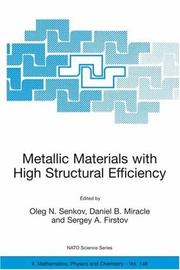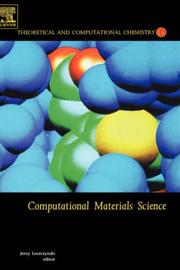| Listing 1 - 10 of 51 | << page >> |
Sort by
|

Abstract | Keywords | Export | Availability | Bookmark
 Loading...
Loading...Choose an application
- Reference Manager
- EndNote
- RefWorks (Direct export to RefWorks)
Biomimetics --- Growth --- Materials science

ISBN: 1886362734 9781886362734 1886362742 9781886362741 Year: 2004 Publisher: Warrendale (Pa.) : Assoc. for Iron & Steel Technology,
Abstract | Keywords | Export | Availability | Bookmark
 Loading...
Loading...Choose an application
- Reference Manager
- EndNote
- RefWorks (Direct export to RefWorks)
Materials science --- Metallurgy --- Technological innovations

ISBN: 3540407340 Year: 2004 Publisher: Berlin Springer
Abstract | Keywords | Export | Availability | Bookmark
 Loading...
Loading...Choose an application
- Reference Manager
- EndNote
- RefWorks (Direct export to RefWorks)
Crystals --- Materials science --- Texture (Crystallography)

ISBN: 0878499563 Year: 2004 Publisher: Zürich Trans tech publ.
Abstract | Keywords | Export | Availability | Bookmark
 Loading...
Loading...Choose an application
- Reference Manager
- EndNote
- RefWorks (Direct export to RefWorks)
Manufacturing processes --- Materials handling --- Materials science --- Materials

ISBN: 0878499415 Year: 2004 Publisher: Zürich Trans Tech
Abstract | Keywords | Export | Availability | Bookmark
 Loading...
Loading...Choose an application
- Reference Manager
- EndNote
- RefWorks (Direct export to RefWorks)
Materials science --- Materials --- Congresses --- Research --- Congresses

ISBN: 1280461845 9786610461844 1402021127 1402020600 Year: 2004 Publisher: Dordrecht : Springer Netherlands,
Abstract | Keywords | Export | Availability | Bookmark
 Loading...
Loading...Choose an application
- Reference Manager
- EndNote
- RefWorks (Direct export to RefWorks)
In the fall of 1998, Prof. Sergey Firstov invited me to the Frantcevych Institute for Problems of Materials Science (IPMS) in Kyiv, Ukraine to discuss possible collaborations in the area of advanced metals research. During this visit, a strong mutual interest was evident in a broad range of structural metals technologies, and a quick friendship was established. Countless subsequent emails and a reciprocal visit to the U. S Air Force Research Laboratory by Prof. Firstov and a team of scientists from IPMS ensued to discuss and detail a broad collaboration in the area of structural metals. Two years after the initial visit, a major investment by the U. S. Air Force Office of Scientific Research (AFOSR) was established to pursue the technologies defined by these interactions. The annual reviews of the AFOSR Ukrainian Metals Initiative were held in late May, a most beautiful time in Kyiv when the lilacs are in bright display and the air is scented with the smell of falling blossoms from the chestnut trees that line the major streets and many parks. The sunny days and mild evenings provide a welcome break from winter, and on weekend evenings festive crowds spill onto the Khreshchatyk, Kyiv’s downtown boulevard, to listen to street musicians, watch jugglers and comedians, or simply to celebrate with friends. The annual reviews featured long days of intensive discussion of technical progress, followed in the evenings by the warm hospitality of the Ukrainian hosts.
Materials science. --- Materials Science. --- Characterization and Evaluation of Materials. --- Material science --- Physical sciences

ISBN: 0444513000 9786611048716 1281048712 0080529631 9780444513007 9780080529639 Year: 2004 Publisher: Boston ; Amsterdam : Elsevier,
Abstract | Keywords | Export | Availability | Bookmark
 Loading...
Loading...Choose an application
- Reference Manager
- EndNote
- RefWorks (Direct export to RefWorks)
Computational tools have been permanently deposited into the toolbox of theoretical chemists. The impact of new computational tools can hardly be overestimated, and their presence in research and applications is overwhelming. Theoretical methods such as quantum mechanics, molecular dynamics, and statistical mechanics have been successfully used to characterize chemical systems and to design new materials, drugs, and chemicals. This volume on Computational Material Sciences covers selected examples of notable applications of computational techniques to material science. The chapters contained
Materials science --- Chemistry --- Computer simulation. --- Material science --- Physical sciences --- Mathematical models. --- Materials science - Computer simulation. --- Chemistry - Computer simulation.
Periodical
ISSN: 23001909 Year: 2004 Publisher: Warsaw : Polish Academy of Sciences
Abstract | Keywords | Export | Availability | Bookmark
 Loading...
Loading...Choose an application
- Reference Manager
- EndNote
- RefWorks (Direct export to RefWorks)
Metallurgy --- Materials science --- Métallurgie --- Science des matériaux --- Periodicals. --- Périodiques --- Materials science. --- Metallurgy. --- Material science --- materials science --- materials and chemistry --- metals and metallurgy --- Oxygen --- Chemical engineering --- Metals --- Ores --- Smelting --- Physical sciences --- Industrial applications

ISBN: 9780387209395 0387209395 9780387266916 0387266917 Year: 2004 Publisher: New York Springer-Verlag
Abstract | Keywords | Export | Availability | Bookmark
 Loading...
Loading...Choose an application
- Reference Manager
- EndNote
- RefWorks (Direct export to RefWorks)
This introduction to materials science both for students of engineering and physics and for the interested general public examines not only the physical and engineering properties of virtually all kinds of materials, but also their history, uses, development, and some of the implications of resource depletion and recycling. It covers all topics on materials from an entirely novel perspective: the role materials have played throughout history in the development of humankind and technologies. Specifically, it shows the connection between the technical and the cultural, economic, ecological, and societal aspects of materials science. It aims to whet the appetite of its readers and inspire them to further explore the properties and applications of metals, alloys, ceramics, plastics, and electronic materials by presenting easily understandable explanations and entertaining historical facts. It is also intended to raise the reader's awareness of their obligations to society as practicing engineers and scientists. The new edition includes numerous additions and clarifications such as: The treatment of "high-tech ceramics" has been substantially expanded to include topics such as silicon nitride ceramics, transformation-toughened zirconia, alumina, bioceramics, cutting tools, cermets, armor, and more. A section on composite materials has been added, including fiber-reinforced, particular, and laminar composites. New trends such as "nanomaterials by severe plastic deformation," and a rendition of Moore's law have been added to the final chapter. The Economic and Environmental Considerations chapter has been rewritten and expanded to include updated statistical information on prices of materials, production figures, world reserves, consumption, and new recycling data. The iron and steel production statistics, and the gold production and consumption figures have been updated. Acclaim for the first edition of Understanding Materials Science: "Hummel tries - and succeeds - to relate the historical developments in the various materials eras (stone, bronze, iron, and electronic) to the principle defining features of the various classes of materials...An additional aspect of materials that is nicely covered ¦ is the environmental and economic implications of society's use of materials. The discussions of world resources, the remaining supply of various materials and the fundamental underlying waste disposal and recycling will be fascinating to both the science student and the general reader." Physics Today "By showing how materials shaped civilization and advanced it at critical times, the author has created a book that should arouse the interest of readers. The history, properties and applications of materials that are woven into each chapter should be a good motivating force for learning." Choice Magazine " ¦Hummel ¦has succeeded admirably in rendering intrinsically complicated topics, such as polymerization, palatable, and digestible...This mix of proper science and respectable history is something new among the plethora of materials science books." MRS Bulletin
Materials science. --- Science des matériaux --- 620.1 --- elektronica --- keramische materialen --- kunststoffen --- materialen --- mechanica --- milieu --- materiaalonderzoek --- Materials science --- Material science --- Physical sciences

ISBN: 1280190450 9786610190454 1402021178 1402017677 Year: 2004 Publisher: Dordrecht ; Boston : Kluwer Academic Publishers,
Abstract | Keywords | Export | Availability | Bookmark
 Loading...
Loading...Choose an application
- Reference Manager
- EndNote
- RefWorks (Direct export to RefWorks)
As a result of the advancements in algorithms and the huge increase in speed of computers over the past decade, electronic structure calculations have evolved into a valuable tool for characterizing surface species and for elucidating the pathways for their formation and reactivity. It is also now possible to calculate, including electric field effects, STM images for surface structures. To date the calculation of such images has been dominated by density functional methods, primarily because the computational cost of - curate wave-function based calculations using either realistic cluster or slab models would be prohibitive. DFT calculations have proven especially valuable for elucidating chemical processes on silicon and other semiconductor surfaces. However, it is also clear that some of the systems to which DFT methods have been applied have large non-dynamical correlation effects, which may not be properly handled by the current generation of Kohn-Sham-based density functionals. For example, our CASSCF calculations on the Si(001)/acetylene system reveal that at some geometries there is extensive 86 configuration mixing. This, in turn, could signal problems for DFT cal- lations on these systems. Some of these problem systems can be addressed using ONIOM or other “layering” methods, treating the primary region of interest with a CASMP2 or other multireference-based method, and treating the secondary region by a lower level of electronic structure theory or by use of a molecular mechanics method. ACKNOWLEDGEMENTS We wish to thank H. Jónsson, C. Sosa, D. Sorescu, P. Nachtigall, and T. -C.
Materials science --- Chemistry --- Computer simulation. --- Data processing. --- Material science --- Physical sciences
| Listing 1 - 10 of 51 | << page >> |
Sort by
|

 Search
Search Feedback
Feedback About
About Help
Help News
News